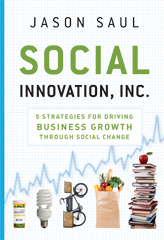Faculty bookshelf: Profits first - social good second
Social Innovation, Inc. by Jason Saul suggests that business growth can be the most effective way to bring about social change
By Chris Serb '09
 |
|
Walmart, Exxon and Coca-Cola aren’t the first entities that come to mind when one thinks of the world’s biggest social activists. Yet their profit-driven strategies may have a far broader social impact than traditional corporate philanthropy.
So argues Kellogg faculty member Jason Saul in his new book Social Innovation, Inc.: 5 Strategies for Driving Business Growth Through Social Change (Jossey-Bass). Saul, who is also CEO of social strategy consulting firm Mission Measurement LLC, found that traditional corporate social responsibility (CSR) efforts, such as organized volunteer events, have scant impact on the social problems they seek to address. Instead, Saul discovered dozens of business strategies — placing profits first, social responsibility second — that had convincing and measurable results, both social and economic.
“This book certainly should be appealing to nonprofit executives or socially conscious people, but it’s specifically designed as a corporate strategy book,” says Saul, a lecturer of social enterprise at Kellogg. “It’s written from the business perspective rather than from the ‘how we save the world’ perspective.”
Saul, formerly an attorney, has been researching social strategies for a long time. In 1994, he founded the Center for What Works, a Chicago-based nonprofit that aims to improve social-sector results through nonprofit benchmarking. He has shared his findings in numerous articles and books, including Benchmarking for Nonprofits: How to Measure, Manage and Improve Performance (Fieldstone Alliance, 2006). At Mission Measurement, his clients include McDonald’s, Kraft Foods and the American Red Cross.
One of Saul’s most compelling case studies involves WellPoint, the Indianapolis-based health insurance giant. WellPoint saw a market failure in the large number of 19- to 29-year-olds who lacked health insurance. Rather than direct its charitable dollars toward extra coverage, WellPoint created a targeted low-cost insurance product, Tonik, that profitably expanded coverage to 780,000 previously uninsured people.
“A donation of $5 million or $10 million might have reached a few thousand people,” Saul says. “Which had a bigger social impact — giving it away to a few thousand people, or using ingenuity and business savvy to deliver a product on a wide scale to an underserved market? Ultimately, we’re a lot more likely to solve social problems by using the market instead of leftover dollars.”
Other examples of profitable social innovation include Walmart, whose affordable generic-prescriptions program grew its pharmacy market share while saving customers $2 billion; European grocery giant Tesco, which gained a foothold in the U.S. market by opening small stores in the “food deserts” of American inner cities; and the sustainability revolution, which turned the environment from a negative externality into a business opportunity through energy-cost savings and the growing power of “green” branding.
“One thing I discovered is that a lot of companies are doing social innovation without actually knowing they’re doing it,” Saul says. “Walmart didn’t design its $4 generic-drug program as a social strategy, but as a business strategy to increase share in the pharmaceutical market.
“The point I want to make, and the reason I wrote this book, is that the underlying linkage between social change and profits is something we should be conscious of, so we don’t keep falling into it by accident.”


